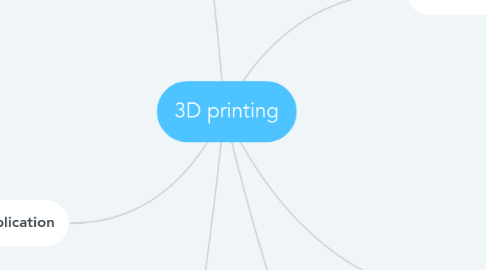
1. application
1.1. manufacturing
1.1.1. food production
1.1.1.1. chocolate
1.1.1.2. pancake
1.1.1.3. candy
1.1.2. prototyping
1.1.3. clothing
1.1.4. furniture
1.2. medical use
1.2.1. bio-printing
1.2.1.1. print organ with patients' own cells
1.2.1.2. cartilage
1.2.1.2.1. nose
1.2.1.2.2. ears
1.2.1.3. kidney
1.2.2. medical equipment
1.3. infrastructure
1.3.1. building houses
1.4. art piece
1.5. education
1.5.1. geometrics
1.5.1.1. 3D printing polyhedrons for demostration
1.5.2. geography
1.5.2.1. relief maps and graphs
2. advantage
2.1. lower production cost
2.1.1. material efficient
2.1.1.1. most material use on product
2.1.2. prototyping
2.2. more stable quality
2.3. more detailed
2.4. cusomize
2.4.1. e.g. bio-printing
2.5. more advance medical technology
2.5.1. e.g. Patient that do not need to queue for a long time to receive an organ from dead body
2.6. makes teaching and research easier
2.6.1. by printing out polyhedrons, abstract demonstration would be more specific and clear to students
3. material used
3.1. plastic
3.1.1. thermoplastic
3.1.2. photopolymer
3.1.3. rubber
3.2. metal
3.3. food
3.3.1. chocolate
3.3.2. pancake batter
3.4. paper (laminated)
3.5. clay
4. introduction
4.1. history
4.1.1. started in 1980s
4.1.1.1. in Nagoya, Japan
4.2. definition
4.2.1. three-dimensional printing
4.2.2. additive manufacturing
4.2.2.1. layering
4.3. process
4.3.1. create blueprint
4.3.1.1. design yourself
4.3.1.1.1. TinkerCAD
4.3.1.1.2. 3DSlash
4.3.1.1.3. SketchUp
4.3.1.2. modeled design
4.3.1.2.1. Thingiverse
4.3.1.2.2. Shapeway
4.3.2. printing
4.3.2.1. model translated into a series of 2-D “slices”
4.3.2.2. giving orders where to start
5. types
5.1. Extrusion
5.1.1. Fused deposition modeling (FDM)
5.2. Photopolymerisation
5.2.1. use laser/ light (DLP) to trigger reaction between photopolymer
5.2.2. Continuous Liquid Interface Production (CLIP)
5.2.2.1. faster
5.3. Powder Bed
5.3.1. binding powdered materials with chemical/ heat
5.4. Laminated
5.4.1. binding thin sheets of material together
6. disadvantage/ development difficulties
6.1. time consuming
6.1.1. take whole day to produce
6.2. relatively mechanically weak
6.3. limited material choice
6.4. costly (for most households)
6.5. rough surface
6.5.1. extra step is needed
